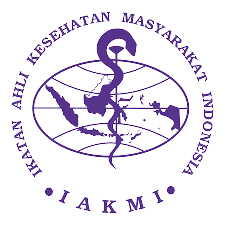EPIDEMIOLOGICAL ANALYSIS OF COVID-19 CASES IN GORONTALO CITY (CASE STUDY OF KOTA TENGAH SUBDISTRICT)
Abstract
Coronavirus Disease or COVID-19, is still a concern around the world. COVID-19 is a new disease that was previously unknown before it finally appeared in Wuhan, China, in December 2019. A new strain of coronavirus causes COVID-19, The Novel Coronavirus 2019 (2019-nCoV), and is officially named Severe Acute Respiratory Syndrome-Coronavirus 2 (SARS-CoV- 2). The novelty of this study is to analyze the epidemiology of Covid-19 cases in Gorontalo City. The purpose of this study is to analyze the epidemiology of Covid 19 disease in Gorontalo City. The type of research used is an observational survey with a descriptive approach. The population and samples are all covid 19 patients in 2020 – 2022 who live in the Puskesmas Kota Tengah area, Kota Tengah Subdistrict, Gorontalo City. The sampling technique is Purposive Sampling. The results showed the highest prevalence of covid 19 in 2021 was 2.3%, the frequency distribution of covid 19 sufferers by the highest sex in 2021 was 344 people (55.6%), the frequency distribution based on the age group of covid 19 sufferers was highest in 2022 age group 25-29 years as many as 25 people (23.6%), frequency distribution based on the month of the highest incidence in 2022 February as many as 67 people (63.2%), frequency distribution based on the highest residence in 2020 residences in Pulubala Village were 76 people (25.0%) and the highest CFR in 2021 was 3.6%. The Conclusion is the prevalence of covid-19 in 2020 was 1.1%, there was an increase in covid-19 cases in 2021 to 2.3%, and there was a decrease in mid-2022 with a prevalence of 0.4%.
Keywords: Covid-19; Epidemiology; People; Place; Time.
Full Text:
PDFReferences
Zhang L, Wu F, Zhu R, Wu D, Ding Y, Zhang Z, et al. A protocol for a systematic review. 2020;9(January):10-2.
Abudi R, Mokodompis Y, Magulili AN. Stigma Terhadap Orang Positif Covid-19. Jambura J Heal Sci Res. 2020;2(2):77-84.
Susilo A, Rumende CM, Pitoyo, Santoso, Yulianti, Herikurniawan, et al. Coronavirus Disease 2019: Tinjauan Literatur Terkini. J Penyakit Dalam Indones. 2020;7(1): 45 6.
Buana DR. Analisis Perilaku Masyarakat Indonesia dalam Menghadapi Pandemi Virus Corona (Covid-19) dan Kiat Menjaga Kesejahteraan Jiwa. J Sos dan Budaya Syar'i. 2020;7(3).
Muhyidin M. Covid-19, New Normal, dan Perencanaan Pembangunan di Indonesia. Indones J Dev Plan. 2020;2(2).
Mona N. Konsep Isolasi Dalam Jaringan Sosial Untuk Meminimalisasi Efek Contagious (Kasus Penyebaran Virus Corona Di Indonesia). J Sos Hum Terap. 2020;2(2).
Mokodompis Y, Irwan. Detection of Anti-Severe Acute Respiratory Syndrome Coronavirus 2 ( Sars- International Journal of Health Science & Medical Research. Int J Heal Sci Med Res. 2022;1(1).
Ladimo MP, Irwan I. Middle East Respiratory Syndrome- Corona Virus (MERS-CoV) Menggegerkan Dunia Bagian Timur. J Heal Sci Gorontalo J Heal Sci Community [Internet]. 2020;4(2):18-28. Available from: https://ejurnal.ung.ac.id/index.php/gojhes/article/view/4666
WHO. coronavirus-2019. 2020.
Putra RAM. Kendala Pelaksanaan Pembelajaran Jarak Jauh (PJJ) Dalam Masa Pandemi Ditinjau Dari Media Pembelajaran. J Chem Inf Model. 2020;
Kementrian Kesehatan RI. Info Infeksi Emerging Kementerian Kesehatan RI. Jakarta; 2020.
Kementrian Kesehatan RI. Pedoman Pencegahan Dan Pengendalian Coronavirus Disesase (Covid-19). Jakarta; 2020.
Kementrian Kesehatan RI. Keputusan Menteri Kesehatan no 382 Tahun 2020 tentang protokol kesehatan bagi masyarakat di tempat dan fasilitas umum dalam rangka pencegahan dan pengendalian corona virus disease 2019 (COVID-19). [Internet]. Jakarta; 2020. Available from: www.kemenkes.go.id.
Gugus Tugas Covid-19. Data Sebaran Covid-19. Satuan Tugas Penanganan COVID-19. 2021.
Notoatmodjo S. Metodologi Penelitian Kesehatan. Rineka Cipta; 2010.
Amalia L, Irwan, Hiola F. Analisis Gejala Klinis dan Peningkatan Kekebalan Tubuh Untuk Mencegah Penyakit COVID-19. Jambura J Heal Sci Res. 2020;2(2).
Artikel I. Jurnal Health Sains , Vol . 1 No . 6 , Desember 2020. 2020;1(6):414-26.
DOI: https://doi.org/10.37905/ijhsmr.v2i1.16226
Refbacks
- There are currently no refbacks.









